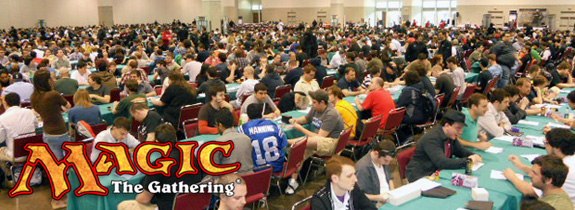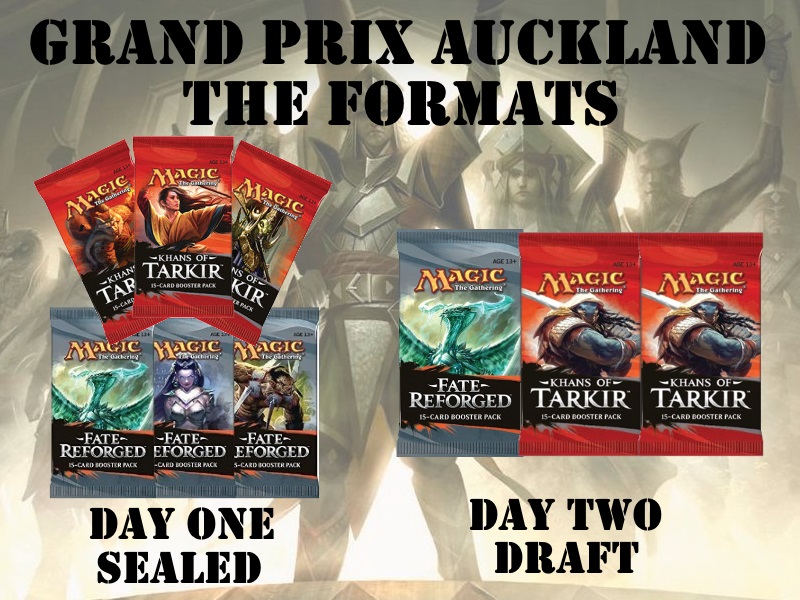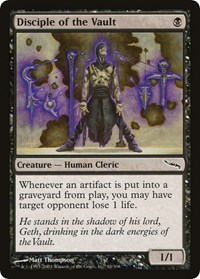The Moore Report - Grand Prix Auckland Preparation
.jpg)
The Moore Report - Grand Prix Auckland Preparation
With Henry Moore
It’s a very exciting time, guys. It’s the extra special biennial New Zealand Grand Prix in less than two weeks! I hope everyone who can make it gets a chance to come along. Even if you don’t fancy your chances at the title, the tournament is always great fun. There’s a whole heap of awesome side-events, a bunch of top-notch vendors, a metric tonne of Magic to watch and play and most importantly there will be a very large number of awesome people in attendance. If someone told me that I was going to come in last place at this GP, I would probably still turn up. I love seeing all the players and judges from around the country (and the world, too). It’s great to catch up, share war stories and get into the comradery that happens at a huge event like this. It feels like everyone you know has your back, and it’s exciting to see who among those people do well.
So, as I said, if you get a chance and you’re on the fence, I wholeheartedly encourage you to try and make it in, even if it’s just for a day or one side event. The atmosphere is awesome, the Magic is awesome and I’m awesome…Ok, the last one isn’t relevant, but still true. Maybe my being awesome is the final reason needed to convince you to come. Who am I to judge?

Right, well, now that everyone is clearly convinced, let’s get to the point: preparation. A big tournament like this is fun, yes, but as Magic players we like winning. To win a lot, you need to practice. I’m here to pass on a few hints for that practice – mostly for those looking to come along to this Grand Prix who maybe don’t have the limited format down and don’t have much time to do draft after draft.
Hint 1: Watch videos. As you’re probably aware, there is a lot of Magic related content on the internet. This content is invaluable as a great way to catch up on a format you’re not used to, or even just to get differing opinions on cards or strategy. My favourite is Channel Fireball, but there are others out there. StarCityGames is another, but you need a premium account for that one, and they don’t put much limited content up anyway. You can also check out TCG Player, who employs a lot of talented writers.
Watch as many of these videos as you can, whenever you have spare time, since you’ll be absorbing information from players who are very good and (presumably) have experience in the format. It’s nice not having to do 20 drafts to know that Aven Surveyor is the best blue common. That might not have been clear to you before looking at the set, so just hearing that one sentence from someone like Luis Scott Vargas has already sky-rocketed your preparation. You’ll now know to play your surveyors in your sealed deck, and also that if they’re passed to you in a draft that blue is probably open (or that the players to your right don’t like listening to Luis Scott Vargas, which is a viewpoint I discourage).

One last thing I’ll say about watching videos is not to limit yourself to one or two writers that you like. It’s tempting, but it’s definitely very important to diversify the viewpoints that you’re listening to. Different players will have different opinions, or different ways of looking at the format, so doing this will give you a more well-rounded view of the format. Additionally, when two or more players agree on a point, it’s far more likely to be true, and if you disagreed with it you’re more likely to come around – or at least consider it. I can’t stress enough that watching videos is the most important part of prep, even more important than doing actual drafts.
Hint 2: Speaking of drafts…Yes, this is clearly important. Get your hands on some cards! Watching videos is one thing, but actually playing Magic is the next step. I often find that when watching a video it can be easy to think “oh, yeah, that pick (or play) is obvious”, and then find myself not making the exact same play or pick in practice. The reason for this could either be that I think I’m better than the people making the videos I’m watching (unlikely but not impossible) or that I simply didn’t absorb that piece of information. The concept of learning is an interesting one. It’s a simple fact that not everything you hear, or read, or watch will be recorded perfectly by your brain. If you’re not one of the lucky few with a photographic memory, learning stuff takes some work. This is why just watching videos isn’t enough – it’s great as a base, and you’ll definitely learn a lot, but you won’t take it all in, so crack some packs and dive in.
I strongly suggest doing drafts where the prize includes a “rare redraft”. For those of you who don’t know, this is where the eight players drafting agree that all the rares (and uncommons that have a monetary value) are put back into a pool at the end of the 3 rounds, and the cards are drafted afterwards, the pick order based on performance. This format is great because it incentivises you to do well, but it also doesn’t force you to draft for “value” instead of drafting strategically. In a normal draft I’m going to take a Flooded Strand first no matter what, since it pays for my draft, but in a GP that’s almost never going to happen. When practicing for the GP, you want to imitate GP drafts as closely as possible, which is where the rare redraft system comes in handy. I’d also suggest spreading yourself around. Don’t just draft with one playgroup. If you do that, you might end up learning based on certain biases. For example, one of my friends might really like drafting Sultai, and I know that, so I might keep a hand based on that information and win more (or less) games because of it. Playing with different groups will also allow you to see how different people approach the format, so it’s similar in value to watching videos by various writers.

Don’t worry, I won’t send you off to draft without some actual strategy. The following (that’s “hint three”, for those not keeping up), is a list of general points that I’ve picked up from my preparation that will hopefully give you a head start:
· In sealed, play as many colours as is reasonable. The best way to figure out how many colours this should be is to check out how many nonbasic lands you managed to get. You’ll get at least 3 from the Fate Reforged packs, and you almost always get one in each of the Khans of Tarkir packs too. Having just 5 or 6 means you’re probably just going to end up playing 2 or 3 colours, but if you managed to open a couple of the uncommon triple lands, or even some fetchlands, you might be on track to play a nice spicy 4 or 5 colour brew. If you go past 2 colours with a light splash, consider your deck a midrange or control deck. Play less aggressive creatures, and focus on getting value from your cards either by virtue of the fact that they’re just better in general than your opponents (more colours usually means more premium cards from each colour and less “filler”) or by playing things like Treasure Cruise and Bitter Revelation. Reid Duke has an excellent example of a deck like this in one of his Channel Fireball drafts, which you should check out. It’s a draft, not a sealed, but the game play aspect is very informative.
· Consider your sideboard. A lot of limited players don’t sideboard, outside of the situations where they see their opponent has an Umezawa’s Jitte so they bring in a Naturalize. Sideboarding in limited can be just as important as in constructed, especially in formats such as this. Each clan in this format has a distinct strategy, and because of this certain cards are very good against specific clans. To give you an example, that Force Away that you left in your sideboard is probably quite good against a Sultai player. Their Shambling Attendants which they put so much work into delving into play could cost them up to the full retail price to replay, and that can really set them back enough for you to get a win. Similarly, Barrage of Boulders starts to look really good when your opponent is casting Ponyback Brigades and Sandsteppe Outcasts. Pay attention to your sideboard and I guarantee you’ll do better in this format.
· When you open your pack of Fate Reforged in draft, pick the rare. I’m not kidding. That set has an uncommonly large number of very good rares for limited, to the point where you should almost feel unlucky not to open one. So, unless the rare looks really bad, it’s probably quite good and you should take it. However, don’t get attached. If you consider the fact that you’re taking your rare, have a think about what the players around you are doing. That’s right. As soon as the judge says “pass the pack”, there are probably 8 less gold symbols in those boosters going around. If you picked a Flamerush Rider, but the person to your right picked Mob Rule, you’re probably not going to see many red cards. I’m not saying you have to give up completely, because in the second pack you’re likely to see some red cards, but it’s just something that you should be aware of because it will affect your draft.
· Finally, when drafting, try to pick an enemy colour pair in the first pack. First of all, this allows you to be flexible when moving into the next packs. If you’re black/white, for example, you can end up Mardu or Abzan. If you pick red/green, you can only realistically end up Temur. I haven’t found a draft deck that wasn’t based in a clan be good yet, but I guess it is possible… Additionally, and I’m sure this was intentional on the part of Wizards of the Coast, if you pick an enemy colour pair you get to take advantage of the great enemy colour cards in Fate Reforged. Harsh Sustenance, Grim Contest and War Flare are all quite good, and Ethereal Ambush pulls its weight too….Sorry Cunning Strike, you’re not cutting any mustard where I’m from. So pick an enemy colour and profit (slightly less in blue/red, but that combination is still very good!).
Beyond that, it’s all just experience. Get out there and level up. For my final hint, let me just say this: play grinders, acquire byes. Byes are worth their weight in gold, which is a terrible way of saying they’re amazing because they don’t weigh anything. Disregarding my awful figure of speech, don’t underestimate the power of a couple of byes. It’s too late at this stage to play GPTs, but there is always Friday. A lot of people have work, which is understandable, but if you can get the day off try to get down on Friday. It’s an extra day of Magic: The Gathering, after all, which should be reason enough, but if it’s not consider that your likelihood of making day two is greatly increased by having byes. You get two wins (awesome), and you also gain some extra time to get a Red Bull, a bite to eat and a chance to talk to your friends about how you built your sealed deck. Don’t be afraid to ask for advice. Your friends want you to win as much as you do, so get some second opinions. You can’t change your deck immediately, but you can sideboard in any changes after game one of your matches.
That does it for me today, readers. I’m hyped for the GP, and I hope you are too. See you there!















